NEETS Module 9 − Introduction to Wave− Generation and Wave−Shaping
Pages i,
1−1,
1−11,
1−21,
1−31,
1−41,
2−1,
2−11,
2−21,
2−31,
3−1,
3−11,
3−21,
3−31,
3−41,
3−51,
4−1,
4−11,
4−21,
4−31,
4−41,
4−51, Index
| - |
Matter, Energy,
and Direct Current |
| - |
Alternating Current and Transformers |
| - |
Circuit Protection, Control, and Measurement |
| - |
Electrical Conductors, Wiring Techniques,
and Schematic Reading |
| - |
Generators and Motors |
| - |
Electronic Emission, Tubes, and Power Supplies |
| - |
Solid-State Devices and Power Supplies |
| - |
Amplifiers |
| - |
Wave-Generation and Wave-Shaping Circuits |
| - |
Wave Propagation, Transmission Lines, and
Antennas |
| - |
Microwave Principles |
| - |
Modulation Principles |
| - |
Introduction to Number Systems and Logic Circuits |
| - |
- Introduction to Microelectronics |
| - |
Principles of Synchros, Servos, and Gyros |
| - |
Introduction to Test Equipment |
| - |
Radio-Frequency Communications Principles |
| - |
Radar Principles |
| - |
The Technician's Handbook, Master Glossary |
| - |
Test Methods and Practices |
| - |
Introduction to Digital Computers |
| - |
Magnetic Recording |
| - |
Introduction to Fiber Optics |
| Note: Navy Electricity and Electronics Training
Series (NEETS) content is U.S. Navy property in the public domain. |
PRT is too short, some of the triggers occur when the base is far below cutoff.
The blocking oscillator may then synchronize with every second or third sync pulse.
For example, in figure 3-37, view (A) and view (B) if trigger pulses are applied
every 200 microseconds (5 kilohertz), the trigger that appears at T1 is not of sufficient
amplitude to overcome the cutoff bias and turn on Q1. At T2, capacitor C1 has nearly
discharged and the trigger causes Q1 to conduct. Note that with a 200-microsecond
input trigger, the output PRT is 400 microseconds. The output frequency is one-half
the input trigger frequency and the blocking oscillator becomes a frequency divider.
Q10. What component in a blocking oscillator controls pulse width?
TIME-Base GENERATORS
Radar sets, oscilloscopes, and computer circuits all use sawtooth (voltage or
current) waveforms. a sawtooth waveshape must have a linear rise. The sawtooth waveform
is often used to produce a uniform, progressive movement of an electron beam across
the face of an electrostatic cathode ray tube. This movement of the electron beam
is known as a SWEEP. The voltage which causes this movement is known as SWEEP Voltage
and the circuit which produces this voltage is the SWEEP GENERATOR, or TIME-Base
GENERATOR. Most common types of time-base generators develop the sawtooth waveform
by using some type of switching action with either the charge or discharge of an
RC or RL circuit.
Sawtooth Wave
A sawtooth wave can be generated by using an RC network. Possibly the simplest
sawtooth generator is that which is shown in figure 3-38, view (A). Assume that
at T0 (view (B)), S1 is placed in position P. At the instant the switch closes,
the applied voltage (Ea) appears at R. C begins to charge to Ea
through R. If S1 remains closed long enough, C will fully charge to Ea.
You should remember from NEETS, Module 2, Alternating Current and Transformers,
that a capacitor takes 5 time constants (5TC) to fully charge. As the capacitor
charges to the applied voltage, the rate of charge follows an exponential curve.
If a linear voltage is desired, the full charge time of the capacitor cannot be used because the exponential curve becomes nonlinear during the first time constant.
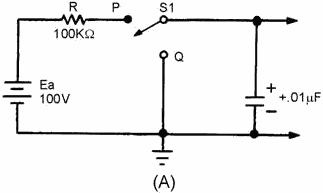
Figure 3-38A. - Series RC circuit.
3-31
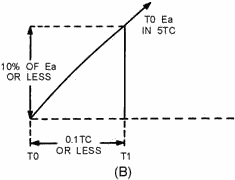
Figure 3-38B. - Series RC circuit.
However, during the first 10 percent of the first time constant, the rate of
voltage change across the capacitor is almost constant (linear). Suppose that S1
is placed in position P at T0, and C is allowed to charge for 0.1 time constant.
This is shown as T0 to T1 in view (B). Notice that the rate of voltage change across
C is nearly constant between T0 and T1. Now, assume that at T1 the switch is moved
from position P to position Q. This shorts the capacitor, and it discharges very
rapidly. If the switch is placed back in position P, the capacitor will start charging
again.
By selecting the sizes of R and C, you can have a time constant of any value
you desire. Further, by controlling the time S1 remains closed, you can generate
a sawtooth of any duration. Figure 3-39 is the Universal Time Constant Chart. Notice
in the chart that if 1 time constant is 1,000 microseconds, S1 (figure 3-38, view
(A )) can be closed no longer than 100 microseconds to obtain a reasonable linear
sawtooth. In this example, C1 will charge to nearly 10 volts in 0.1 time constant.
3-32
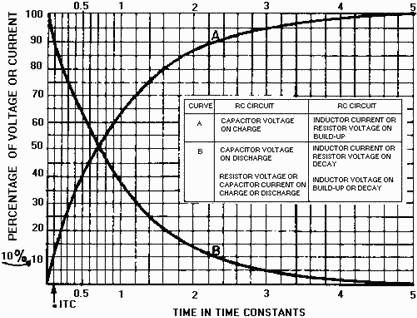
Figure 3-39. - Universal Time Constant Chart.
The dimensions of the sawtooth waveform used in oscilloscopes need to be discussed
before going any further. Figure 3-40 shows a sawtooth waveform with the various
dimensions labeled. The duration of the rise of voltage (T0 to T1) is known as the
SWEEP TIME or ELECTRICAL LENGTH. The electron beam of an oscilloscope moves across
the face of the cathode ray tube during this sweep time. The amount of voltage rise
per unit of time is referred to as the SLOPE of the waveform. The time from T1 to
T2 is the capacitor discharge time and is known as FALL TIME or FLYBACK TIME. This
discharge time is known as flyback time because during this period the electron
beam returns, or "flys" back, from the end of a scanning line to begin the next
line.
3-33
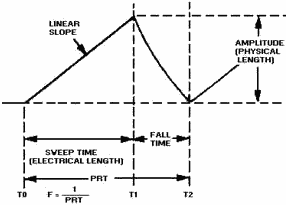
Figure 3-40. - Sawtooth waveform.
The amplitude of the rise of voltage is known as the PHYSICAL LENGTH. It is called
physical length because the greater the peak voltage, the greater physical distance
the beam will move. For example, the amount of voltage needed to move an electron
beam 4 inches is twice the amount needed to move the beam 2 inches across the face
of a given CRT
The voltage rise between T0 to T1 is the LINEAR SLOPE of the wave. The linearity
of the rise of voltage is determined by the amount of time the capacitor is allowed
to charge. If the charge time is kept short (10 percent or less of 1TC), the linearity
is reasonably good.
As stated in the discussion of time-base generators, the waveform produced from
any sawtooth generator must be linear. a LINEAR SAWTOOTH is one that has an equal
change in voltage for an equal change in time. Referring to the Universal Time Constant
Chart in figure 3-39, you can see that the most desirable part of the charge curve
is the first one-tenth (0.1) of the first TC.
Figure 3-41, view (A), is a transistor sawtooth generator. In this figure R1
is a forward-biasing resistor for Q1, C1 is a coupling capacitor, and Q1 is serving
as a switch for the RC network consisting of R2 and C2. With forward bias applied
to Q1, the generator conducts at saturation, and its collector voltage (the output)
is near 0 volts as indicated by the waveform in view (B). The charge felt by C1
is nearly 0. a negative gate is applied to the base of Q1 to cut off Q1 and allow
C2 to charge. The length of time that the gate is negative determines how long Q1
will remain cut off and, in turn, how long C2 will be allowed to charge. The length
of time that C2 is allowed to charge is referred to as the electrical length of
the sawtooth that is produced.
3-34
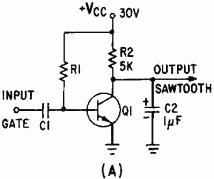
Figure 3-41A. - Transistor sawtooth generator.
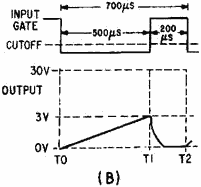
Figure 3-41B. - Transistor sawtooth generator.
The amplitude of the sawtooth that is produced is limited by the value of VCC
that is used in the circuit. For example, if the voltage is 30 volts, and the capacitor
(C2) is allowed to charge to 10 percent of 30 volts, then the amplitude of the sawtooth
will be 3 volts (see figure 3-41, view (B)). If VCC is increased to 40 volts,
C2 will charge to 10 percent of 40 volts and the output will increase in amplitude
to 4 volts. Changing the value of VCC in the circuit changes the
amplitude of the sawtooth waveform that is produced; amplitude determines the physical
length. Since the number of time constants used in the circuit has not been changed,
linearity does not change with a change in VCC.
The linear slope that is produced by the circuit is dependent on two variables;
(1) the time constant of the RC circuit and (2) the gate length of the gate applied
to the circuit. The circuit will produce a linear sawtooth waveshape if the components
selected are such that only one-tenth of 1 TC or less is used. The GATE LENGTH is
the amount of time that the gate is applied to the circuit and controls the time
that the capacitor is allowed to charge. The value of R2 and C2 determines the time
for 1 time constant
3-35
(TC = RC). To determine the number of time constants (or the fraction of 1TC) used, divide the time for 1 time constant into the time that the capacitor is allowed
to charge:

In figure 3-41, view (B), gate length is 500 microseconds and TC is the product
of R2 (5 kilohms) and C2 (1 microfarad). The number of time constants is computed
as follows:
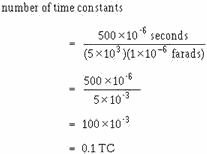
Therefore, 0.1TC is the length of time required to produce a linear rise in the
sawtooth waveform.

shows that an increase in gate length increases the number of time constants.
An increase in the number of time constants decreases linearity. The reason is that
C2 now charges to a greater percentage of the applied voltage, and a portion of
the charge curve is being used that is less linear. The waveform in figure 3-42,
view (A), shows an increase in amplitude (physical length), an increase in the time
that C2 is allowed to charge (electrical length), and a decrease in linearity. If
a smaller percentage of VCC is used, the gate length is decreased.
As shown in view (B), this decreased gate length results in an increase in linearity,
a decrease in the time that C2 is allowed to charge (electrical length), and a decrease
in amplitude (physical length).
3-36
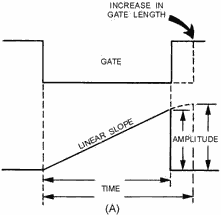
Figure 3-42A. - Relationship of gate to linearity.
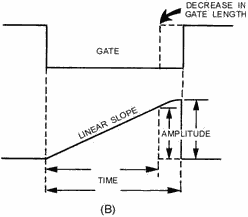
Figure 3-42B. - Relationship of gate to linearity.
Changing the value of R and C in the circuit affects linearity since they control
the time for 1 time constant. For example, if the value of C2 is increased in the
circuit, as shown in figure 3-43, view (A), the time for 1 time constant increases
and the number of time constants then decreases. With a decrease in the number of
time constants, linearity increases. The reason is that a smaller percentage of
VCC is used, and the circuit is operating in a more linear portion
of the charge curve. Increasing the value of the TC (C2 or R2) decreases the amplitude
of the sawtooth (physical length) because C2 now charges to a smaller percentage
VCC for a given time. The electrical length remains the same because
the length of time that C2 is allowed to charge has not been changed.
3-37
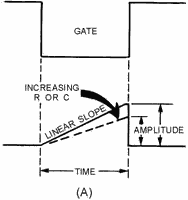
Figure 3-43A. - Relationship of R and C to linearity.
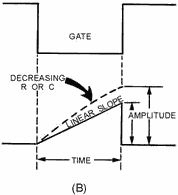
Figure 3-43B. - Relationship of R and C to linearity.
Decreasing the value of the TC (R2 or C2), as shown in figure 3-43, view (B),
results in an increase in the number of time constants and therefore causes linearity
to decrease. Anytime the number of time constants increases, the percentage of charge
increases (see the Universal Time Constant Chart, figure 3- 39), and amplitude (physical
length) increases. Without an increase in gate length, the time that C2 is allowed
to charge through R2 remains the same; therefore, electrical length remains the
same. Linearity is affected by gate length, the value of R, and the value of C;
but is not affected by changing the value of VCC. Increasing the gate length decreases
linearity, and decreasing gate length increases linearity. Increasing R or C in
the circuit increases linearity, and decreasing R or C in the circuit decreases
linearity.
The entire time of the sawtooth, from the time at which the capacitor begins
charging (T0 in figure
3-41, view (B)) to the time when it starts charging again (T2), is known as the
PRT of the wave. The pulse repetition frequency of the sawtooth wave is:
3-38

UNIJUNCTION SAWTOOTH GENERATOR. - So far, you have learned in
this chapter that a switch and an RC network can generate a sawtooth waveform. When
using a unijunction transistor as the switch, a simple sawtooth generator looks
like the circuit in figure 3-44, view (A); the output waveshapes are shown in view
(B). You may want to review unijunction transistors in NEETS, Module 7, Introduction
to Solid-State Devices and Power Supplies, chapter 3, before continuing.
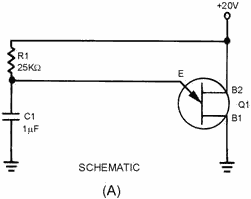
Figure 3-44A. - Unijunction sawtooth generator. SCHEMATIC.
When the 20 volts is applied across B2 and B1, the n-type bar acts as a voltage-
divider. a voltage of 12.8 volts appears at a point near the emitter. At the first
instant, C1 has no voltage across it, so the output of the circuit, which is taken
across the capacitor (C1), is equal to 0 volts. (The voltage across C1 is also the
voltage that is applied to the emitter of the unijunction.) The unijunction is now
reverse biased. After T0, C1 begins to charge toward 20 volts.
At T1, the voltage across the capacitor (the voltage on the emitter) has reached
approximately 12.8 volts. This is the peak point for the unijunction, and it now
becomes forward biased. With the emitter forward biased, the impedance between the
emitter and B1 is just a few ohms. This is similar to placing a short across the
capacitor. The capacitor discharges very rapidly through the low resistance of B1
to E.
As C1 discharges, the voltage from the emitter to B1 also decreases. Q1 will
continue to be forward biased as long as the voltage across C1 is larger than the
valley point of the unijunction.
At T2 the 3-volt valley point of the unijunction has been reached. The emitter
now becomes reverse biased and the impedance from the emitter to B1 returns to a
high value. Immediately after T2, Q1 is reverse biased and the capacitor has a charge
of approximately 3 volts. C1 now starts to charge toward 20 volts as it did originally
(just after T0). This is shown from T2 to T3 in figure 3-44, view (B).
3-39
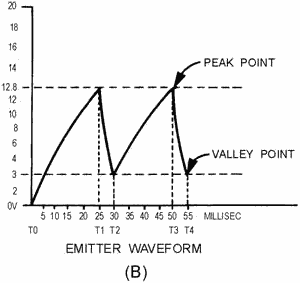
Figure 3-44B. - Unijunction sawtooth generator. Emitter WAVEforM.
The circuit operation from now on is just a continuous repetition of the actions
between T2 and T4. The capacitor charges until the emitter becomes forward biased,
the unijunction conducts and C1 discharges, and Q1 becomes reverse biased and C1
again starts charging.
Now, let's determine the linearity, electrical length, and amplitude of the output
waveform. First, the linearity: To charge the circuit to the full 20 volts will
take 5 time constants. In the circuit shown in figure 3-44, view (B), C1 is allowed
to charge from T2 to T3. To find the percentage of charge, use the equation:
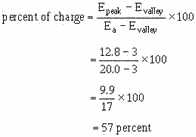
This works out to be about 57 percent and is far beyond the 10 percent required
for a linear sweep voltage. The linearity is very poor in this example.
3-40
|























